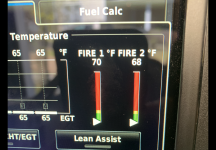I’m going to put a temperature probe in the airstream that exits the cowl. Probably use the TIT input instead of a discrete input on the G3X since it is unused.
With all the discussion about firewall safety and fire/smoke, it makes more sense to me to early detect a large increase in air temp exiting the cowl and shut the gas off ASAP rather than discovering an established fire.
I’m looking for any tips on best place to install the probe if anyone has done this before.
With all the discussion about firewall safety and fire/smoke, it makes more sense to me to early detect a large increase in air temp exiting the cowl and shut the gas off ASAP rather than discovering an established fire.
I’m looking for any tips on best place to install the probe if anyone has done this before.






